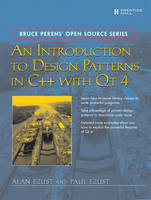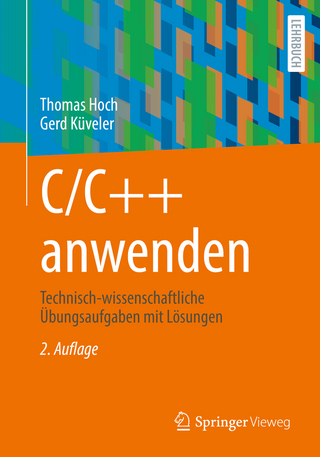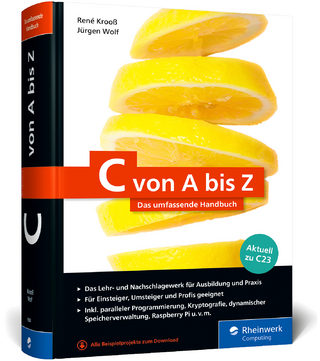
An Introduction to Design Patterns in C++ with Qt 4
Prentice Hall (Verlag)
978-0-13-187905-8 (ISBN)
- Titel erscheint in neuer Auflage
- Artikel merken
Learn C++, Patterns, and Qt 4 Cross-Platform Development
Master C++ and design patterns together, using the world's leading open source framework for cross-platform development: Qt 4.
An Introduction to Design Patterns in C++ with Qt 4 is a complete tutorial and reference that assumes no previous knowledge of C, C++, objects, or patterns. You'll walk through every core concept, one step at a time, learning through an extensive collection of Qt 4.1-tested examples and exercises.
By the time you're done, you'll be creating multithreaded GUI applications that access databases and manipulate XML files--applications that run on platforms including Windows, Linux, Unix, and Mac OS X. Best of all, you'll be writing code that's efficient, reusable, and elegant.
Learn objects fast: classes, inheritance, polymorphism, and more
Master powerful design patterns
Discover efficient high-level programming techniques using libraries, generics, and containers
Build graphical applications using Qt widgets, models, and views
Learn advanced techniques ranging from multithreading to reflective programming
Use Qt's built-in classes for accessing MySQL data
Includes a complete C++ language reference
<>Alan Ezust received his M.Sc in Computer Science from McGill, and has delivered courses on object oriented programming and APIs for over 15 years. He is an instructor and courseware developer at ics.com, leading provider of Trolltech-certified Qt training and services throughout North America. Paul Ezust chairs Suffolk University's Department of Mathematics and Computer Science, and has taught computer science for nearly thirty years. He has done extensive consulting and contract programming.
Preface xixAcknowledgments xxiiiRationale for the Book xxvAbout the Authors xxviiPART I: Introduction to C++ and Qt 4 2Chapter 1: C++ Introduction 51.1 Overview of C++ 6
1.2 A Brief History of C++ 6
1.3 Setup: Open-Source Platforms 7
1.4 Setup: Win32 12
1.5 C++ First Example 12
1.6 Input and Output 16
1.7 Identifiers, Types, and Literals 19
1.8 C++ Simple Types 22
1.9 C++ Standard Library Strings 30
1.10 Streams 31
1.11 The Keyword const 34
1.12 Pointers and Memory Access 36
1.13 const* and *const 40
1.14 Reference Variables 43
Points of Departure 44
Review Questions 45
Chapter 2: Classes 472.1 Structs 48
2.2 Class Definitions 49
2.3 Member Access Specifiers 51
2.4 Encapsulation 54
2.5 Introduction to UML 54
2.5.1 UML Relationships 55
2.6 Friends of a Class 55
2.7 Constructors 56
2.8 Subobjects 58
2.9 Destructors 60
2.10 The Keyword static 61
2.11 Copy Constructors and Assignment Operators 64
2.12 Conversions 67
2.13 const Member Functions 68
Review Questions 79
Chapter 3: Introduction to Qt 813.1 Example Project: Using QApplication and QLabel 82
3.2 Makefile, qmake, and Project Files 83
3.3 Getting Help Online 89
3.4 Style Guidelines and Naming Conventions 90
3.5 The Qt Core Module 91
3.6 Streams and Dates 91
Points of Departure 93
Review Questions 94
Chapter 4: Lists 954.1 Introduction to Containers 96
4.2 Iterators 97
4.3 Relationships 99
Points of Departure 102
Review Questions 103
Chapter 5: Functions 1055.1 Function Declarations 106
5.2 Overloading Functions 107
5.3 Optional Arguments 109
5.4 Operator Overloading 111
5.5 Parameter Passing by Value 116
5.6 Parameter Passing by Reference 118
5.7 References to const 121
5.8 Function Return Values 122
5.9 Returning References from Functions 122
5.10 Overloading on const-ness 124
5.11 Inline Functions 126
5.12 Inlining versus Macro Expansion 127
Review Questions 133
Chapter 6: Inheritance and Polymorphism 1356.1 Simple Derivation 136
6.2 Derivation with Polymorphism 142
6.3 Derivation from an Abstract Base Class 148
6.4 Inheritance Design 152
6.5 Overloading, Hiding, and Overriding 154
6.6 Constructors, Destructors, and Copy Assignment Operators 155
6.7 Processing Command-Line Arguments 158
Points of Departure 164
Review Questions 165
PART II: Higher-Level Programming 166Chapter 7: Libraries 1697.1 Code Containers 170
7.2 Reusing Other Libraries 171
7.3 Organizing Libraries: Dependency Management 173
7.4 Installing Libraries: A Lab Exercise 176
7.5 Frameworks and Components 178
Review Questions 180
Chapter 8: Introduction to Design Patterns 1818.1 Iteration and the Visitor Pattern 182
Review Questions 190
Chapter 9: QObject 1919.1 QObject's Child Managment 194
9.2 Composite Pattern: Parents and Children 196
9.3 QApplication and the Event Loop 200
9.4 Q_OBJECT and moc: A Checklist 209
9.5 Values and Objects 210
9.6 tr() and Internationalization 211
Point of Departure 211
Review Questions 212
Chapter 10: Generics and Containers 21310.1 Generics and Templates 214
10.2 Containers 219
10.3 Managed Containers, Composites, and Aggregates 221
10.4 Implicitly Shared Classes 224
10.5 Generics, Algorithms, and Operators 225
10.6 Serializer Pattern 227
10.7 Sorted Map Example 229
Review Questions 235
Chapter 11: Qt GUI Widgets 23711.1 Widget Categories 239
11.2 QMainWindow and QSettings 240
11.3 Dialogs 244
11.4 Images and Resources 248
11.5 Layout of Widgets 251
11.6 QActions, QMenus, and QMenuBars 260
11.7 QActions, QToolbars, and QActionGroups 262
11.8 Regions and QDockWidgets 270
11.9 Views of a QStringList 272
Points of Departure 274
Review Questions 275
Chapter 12: Concurrency 27712.1 QProcess and Process Control 278
12.2 Threads and QThread 290
12.3 Summary: QProcess and QThread 303
Review Questions 305
Chapter 13: Validation and Regular Expressions 30713.1 Validators 308
13.2 Regular Expressions 310
13.3 Regular Expression Validation 316
Review Questions 319
Chapter 14: Parsing XML 32114.1 The Qt XML Module 325
14.2 Event-Driven Parsing 325
14.3 XML, Tree Structures, and DOM 329
Review Questions 340
Chapter 15: Meta Objects, Properties, and Reflective Programming 34115.1 Anti-patterns 342
15.2 QMetaObject: The MetaObject Pattern 344
15.3 Type Identification and qobject_cast 345
15.4 Q_PROPERTY Macro: Describing QObject Properties 347
15.5 QVariant Class: Accessing Properties 350
15.6 DataObject: An Extension of QObject 353
15.7 Property Containers: PropsMap 355
Review Questions 357
Chapter 16: More Design Patterns 35916.1 Creational Patterns 360
16.2 Serializer Pattern Revisited 373
16.3 The Facade Pattern 381
Points of Departure 389
Review Questions 390
Chapter 17: Models and Views 39117.1 M-V-C: What about the Controller? 392
17.2 Dynamic Form Models 393
17.3 Qt 4 Models and Views 409
17.4 Table Models 411
17.5 Tree Models 417
Review Questions 421
Chapter 18: Qt SQL Classes 42318.1 Introduction to MySQL 424
18.2 Queries and Result Sets 427
18.3 Database Models 429
Review Questions 433
PART III: C++ Language Reference 434Chapter 19: Types and Expressions 43719.1 Operators 438
19.2 Evaluation of Logical Expressions 443
19.3 Enumerations 443
19.4 Signed and Unsigned Integral Types 445
19.5 Standard Expression Conversions 447
19.6 Explicit Conversions 449
19.7 Safer Typecasting Using ANSI C++ Typecasts 450
19.8 Run-Time Type Identification (RTTI) 454
19.9 Member Selection Operators 457
Point of Departure 458
Review Questions 461
Chapter 20: Scope and Storage Class 46320.1 Declarations and Definitions 464
20.2 Identifier Scope 465
20.3 Storage Class 470
20.4 Namespaces 473
Review Questions 478
Chapter 21: Statements and Control Structures 47921.1 Statements 480
21.2 Selection Statements 480
21.3 Iteration 483
21.4 Exceptions 485
Review Questions 502
Chapter 22: Memory Access 50322.1 Pointer Pathology 504
22.2 Further Pointer Pathology with Heap Memory 506
22.3 Memory Access Summary 509
22.4 Introduction to Arrays 509
22.5 Pointer Arithmetic 510
22.6 Arrays, Functions, and Return Values 511
22.7 Different Kinds of Arrays 513
22.8 Valid Pointer Operations 513
22.9 What Happens If new Fails? 515
22.10 Chapter Summary 519
Review Questions 521
Chapter 23: Inheritance in Detail 52323.1 Virtual Pointers and Virtual Tables 524
23.2 Polymorphism and virtual Destructors 526
23.3 Multiple Inheritance 528
Point of Departure 532
23.4 public, protected, and private Derivation 536
Review Questions 539
Chapter 24: Miscellaneous Topics 54124.1 Functions with Variable-Length Argument Lists 542
24.2 Resource Sharing 543
PART IV: Programming Assignments 548Chapter 25: MP3 Jukebox Assignments 55125.1 Data Model: Mp3File 553
25.2 Visitor: Generating Playlists 555
25.3 Preference: An Enumerated Type 556
25.4 Reusing id3lib 559
25.5 PlayListModel Serialization 560
25.6 Testing Mp3File Related Classes 561
25.7 Simple Queries and Filters 561
25.8 Mp3PlayerView 563
25.9 Models and Views: PlayList 565
25.10 Source Selector 566
25.11 Persistent Settings 567
25.12 Edit Form View for FileTagger 568
25.13 Database View 569
Points of Departure 571
PART V: Appendices 572Appendix A: C++ Reserved Keywords 575Appendix B: Standard Headers 577Appendix C: The Development Environment 579Bibliography 601Index 603
| Erscheint lt. Verlag | 14.9.2006 |
|---|---|
| Verlagsort | Upper Saddle River |
| Sprache | englisch |
| Maße | 234 x 182 mm |
| Gewicht | 1025 g |
| Themenwelt | Informatik ► Programmiersprachen / -werkzeuge ► C / C++ |
| ISBN-10 | 0-13-187905-7 / 0131879057 |
| ISBN-13 | 978-0-13-187905-8 / 9780131879058 |
| Zustand | Neuware |
| Haben Sie eine Frage zum Produkt? |
aus dem Bereich



